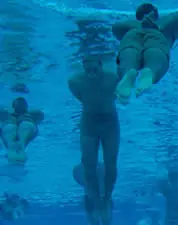If you watched the 2008 Hawaiian Ironman Triathlon on the NBC broadcast, you saw two Navy SEALs parachuting from a helicopter before they went on to successfully complete the race. The two SEALs were SO1 David Goggins and CDR Keith Davids, Commanding Officer SEAL Team ONE.
Make no mistake, the Navy SEALs (Sea, Air, Land) are a special breed, the best of the best. The training necessary to become a SEAL is 2.5 years long. It's not easy. I'll tell you a bit more about that later in the column.
The Navy SEALs were established in January of 1962 as a result of President Kennedy's desire to develop unconventional warfare capability. The original SEAL teams were formed entirely with personnel from Underwater Demolition Teams.
SEALs are charged with conducting counter-guerilla warfare and top-secret operations in water environments. Though comfort in the water is primary to SEAL training—as the name indicates—they also conduct missions from the air and on land, as well. SEAL training, however, is not Ironman training.
Last summer I received a note from Chris Bohnert at the Active Network asking if I'd be interested in reviewing the training plan for a Navy SEAL that was preparing for the Ironman and give some suggestions. I told him I'd be glad to help, if I could.
That connection is how I met Commander Keith Davids.
Keith and I corresponded a few times between July and October, discussing the challenges of training for an Ironman event while holding down a full-time job that includes travel and physical work beyond the normal swimming, cycling and running. While he confronted some of the same issues that every Ironman competitor faces during the training process, several of his challenges were well beyond what mainstream athletes face.

Basic Underwater Demolition/SEALs
students swim 100 meters with
bound hands and feet as part of
their first-phase swimming test.
U.S. Navy Photo
Keith did overcome some significant training challenges, including periods of time where he could do no training, and he successfully completed the event. In perfect made-for-television drama, and completely unplanned, David and Keith ended up crossing the finish line together.
Visiting the SEAL Training Grounds
After the race was over, Keith told me if I was ever in San Diego I should stop by the Naval Amphibious Base Coronado to visit the home of SEAL Team ONE. I took him up on that offer this past February because I wanted to have a look at one of the locations where SEALs are trained.
Some experts consider SEAL training the toughest military training in the world. If not the toughest, then it is definitely ranked within the top handful. Only a small percentage of recruits make it though the infamous Hell Week and move forward to becoming a SEAL.
When I was in San Diego, a new class of recruits was marching around the base. I was there on day 10 and I could see the helmets lining the sidewalk, representing men that had already dropped out. In just a few days, roughly 20 recruits, out of a class of over a hundred, called it quits. And this is a couple of weeks before Hell Week. The hard stuff hasn't even started yet.
Several columns could be devoted to SEAL training, but here I will barely scratch the surface. I'll give you some reference links at the end of the column and I will tell you that Hell Week is 5.5 days of constant motion—physical and mental challenges beyond the imagination. All of the challenges are completed on roughly four hours of sleep during the entire 5.5 days. That is no typo.
The men that survive this training are on the frontline duty ensuring that the USA and its allies are protected from those planning to do harm.


